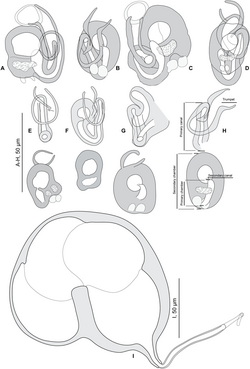Biology:Pseudorhabdosynochus riouxi
| Pseudorhabdosynochus riouxi | |
|---|---|

| |
| Sclerotised genital parts | |
| Scientific classification | |
| Domain: | Eukaryota |
| Kingdom: | Animalia |
| Phylum: | Platyhelminthes |
| Class: | Monogenea |
| Order: | Dactylogyridea |
| Family: | Diplectanidae |
| Genus: | Pseudorhabdosynochus |
| Species: | P. riouxi
|
| Binomial name | |
| Pseudorhabdosynochus riouxi (Oliver, 1986)[1]
| |
Pseudorhabdosynochus riouxi is a species of diplectanid monogenean parasitic on the gills of dusky grouper Mycteroperca marginata. It was described by Guy Oliver in 1986 as Cycloplectanum riouxi,[2] then transferred to the genus Pseudorhabdosynochus by Santos, Buchmann & Gibson in 2000.[1] The species has been redescribed by Chaabane et al. in 2017.[3]
Description
Pseudorhabdosynochus riouxi is a small monogenean, 0.3 mm in length.[2] The species has the general characteristics of other species of Pseudorhabdosynochus, with a flat body and a posterior haptor, which is the organ by which the monogenean attaches itself to the gill of is host. The haptor bears two squamodiscs, one ventral and one dorsal. The sclerotized male copulatory organ, or "quadriloculate organ", has the shape of a bean with four internal chambers, as in other species of Pseudorhabdosynochus.[4]
The vagina includes a sclerotized part, which is a complex structure. Chaabane, Neifar, and Justine, in 2017 considered that the three species Pseudorhabdosynochus riouxi, Pseudorhabdosynochus bouaini, and Pseudorhabdosynochus enitsuji shared a common general structure of the sclerotized vagina with a conspicuous spherical secondary chamber and proposed to accommodate them within a ‘Pseudorhabdosynochus riouxi group’.
Etymology
The name of the species, riouxi, honours Professor Jean-Antoine Rioux, "as President of the Société Française de Parasitologie".[2]
Hosts and localities
The type-host is the dusky grouper Mycteroperca marginata (Perciformes, Epinephelidae) sometimes designated by its synonyms in parasitological publications (Epinephelus guaza or Epinephelus marginatus). The type-locality is Off Cap Béar (Mediterranean Sea), France.[2] Other localities have been mentioned.[3]
References
- ↑ 1.0 1.1 Santos, Cláudia Portes; Buchmann, Kurt; Gibson, David I. (2000). "Pseudorhabdosynochus spp. (Monogenea: Diplectanidae) from the gills of Epinephelus spp. in Brazilian waters". Systematic Parasitology 45 (2): 145–153. doi:10.1023/A:1006232029426. ISSN 0165-5752. PMID 10743859.
- ↑ 2.0 2.1 2.2 2.3 Oliver, Guy (1986). "Cycloplectanum riouxi n. sp., une nouvelle espèce de Diplectanidae (Monogenea, Monopisthocotylea) parasite d'Epinephelus guaza (Linnaeus, 1758) (Pisces, Serranidae)". Systematic Parasitology 8 (4): 317–322. doi:10.1007/BF00009739. ISSN 0165-5752.
- ↑ 3.0 3.1 Chaabane, Amira; Neifar, Lassad; Justine, Jean-Lou (2017). "Diplectanids from Mycteroperca spp. (Epinephelidae) in the Mediterranean Sea: Redescriptions of six species from material collected off Tunisia and Libya, proposal for the "Pseudorhabdosynochus riouxi group", and a taxonomic key". PLOS ONE 12 (2): e0171392. doi:10.1371/journal.pone.0171392. ISSN 1932-6203. PMID 28152034. Bibcode: 2017PLoSO..1271392C.

- ↑ Kritsky, D. C.; Beverley-Burton, M. (1986). "The status of Pseudorhabdosynochus Yamaguti, 1958, and Cycloplectanum Oliver, 1968 (Monogenea: Diplectanidae)". Proceedings of the Biological Society of Washington 99: 17–20. https://www.biodiversitylibrary.org/page/34595480.

Wikidata ☰ Q2856007 entry
 |



